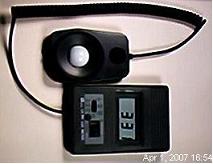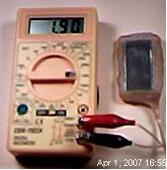
| |
 |
![]()
Sanding the round head off to get wider angle: Taking a LED that produces most of its light in a 12 degree angle and sanding or grinding off the rounded head to a flat will produce a wide angle LED. If one leaves the scratches then the light energy output goes down about 25% of the original. However, if one paints the scratches with anything clear such as epoxy, glue, clear sprays, lacquer, rust-oleum clear top coat, this allows more of the light to go out the front. With scratches some of the light is reflected back and goes out the back. Getting rid of the scratches improves the overall forwarded light output to 125 percent over the round forward light energy readings. The 12 degree light spread changes to about 90-100 degree spread. The light intensity falling at a distance goes down about 11x. However, many times for close up tasks, lighting a wide angle is more usefully than a narrow. The biggest advantage is the change from spot to flood type lighting.
 Light measurements: The LX-101 Lux meter from Electronix Express (1-800 972 2225) part no. 01LX101
for $65.95 works well. Comparative measurements at a know distance say one foot will give comparative light
intensities. This can be done in a black plastic bag to cut down light from other sources. If the LED is placed in
close contact with the light meter then comparative light energy (total light) can be measured between light
sources. If one measure the light say 6" or 12" away from the source then one is measuring light intensity. Both
of these ways of measuring are good for determining the relative efficiency of the LED one to another.
Light measurements: The LX-101 Lux meter from Electronix Express (1-800 972 2225) part no. 01LX101
for $65.95 works well. Comparative measurements at a know distance say one foot will give comparative light
intensities. This can be done in a black plastic bag to cut down light from other sources. If the LED is placed in
close contact with the light meter then comparative light energy (total light) can be measured between light
sources. If one measure the light say 6" or 12" away from the source then one is measuring light intensity. Both
of these ways of measuring are good for determining the relative efficiency of the LED one to another.
Another more accurate way to measure total light output energy is to use a silicon photo cell inside a small black box with a hole the size of the LED in one side. The arrangement is such that the LED is held close but at a fixed distance directly in front of the photo cell. The Photo cell is hooked to a digital current meter to measure relative current flow thus translating to light energy.
 MCD (mili-candela) is a measure of light intensity not total light energy. MCD is becoming more and more a sales
point without understanding the misleading ramifications it presents. Light intensity is energy over a given unit of area. It
only indicates how hot a spot of light one can engineer into the unit. In other words LEDs are being designed to
produce more and more mcd and as a result have a hot smaller and smaller spot that is being measured. Many times
the result is too narrow for common use.
MCD (mili-candela) is a measure of light intensity not total light energy. MCD is becoming more and more a sales
point without understanding the misleading ramifications it presents. Light intensity is energy over a given unit of area. It
only indicates how hot a spot of light one can engineer into the unit. In other words LEDs are being designed to
produce more and more mcd and as a result have a hot smaller and smaller spot that is being measured. Many times
the result is too narrow for common use.
LED viewing angle degrees: As the viewing angle for a LED decreases the MCD goes up. Theoretically if all of the
light energy for a 120 degree LED were concentrated into a 12 degree angle then we get the ratio of the square of
these numbers or 100 times more light intensity. Due to leakage into other directions one doesn't in practice see any
where near this result. It turns out to be about a bit more than 10 times more light intensity at the smaller angle. Thus as a simple rough rule of
thumb the intensity goes up as the angle goes down by a bit more than approximately the ratio of the two angles.
Offered by Mike.